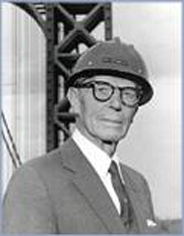
"In bridge designing, the aesthetics are quite as important as engineering details. It is a crime to build an ugly bridge."
Swiss-born and educated civil engineer and designer Othmar Hermann Ammann immigrated to New York City in 1904 and began a celebrated career designing bridges.
In 1912 he started working for the renowned bridge designer Gustav Lindenthal, as assistant chief engineer, to guide the construction of the Hell Gate Bridge and the Sciotoville Bridge. His penchant for combining graceful symmetry and harmonious proportions with utility and strength began to unfold in his elegant designs, ushering in a new era in bridge design. Exposed steel, slender decks, and anchorage aesthetics were Ammann hallmarks. It was during this period that he established himself as a consulting engineer and developed the preliminary designs for New York's acclaimed George Washington Bridge. He served as chief engineer of the Port Authority of New York from 1930 to 1937 and director of engineering from 1937 to 1939.
In 1933, he became chief engineer for the Triborough Bridge and Tunnel Authority and guided the construction of many of New York's signature bridges, including the Triborough, the Henry Hudson, the Bayonne, the Goethals, the Bronx-Whitestone, and the Marine Parkway bridges. He was also responsible for managing the building of the Lincoln Tunnel. In addition, he sat on the Board of Engineers in charge of San Francisco's Golden Gate Bridge, which opened in 1937. In 1939 he opened his own engineering office, then teamed with Charles Whitney in 1946 to form Ammann and Whitney. Through this partnership, he was able to collaborate on some of the best-known American bridges, including the Verrazano-Narrows, the Delaware Memorial, and the Walt Whitman bridges.
In 1964, Amman was awarded the National Medal of Science from President Lyndon Johnson, the first time the medal was given to a civil engineer. The citation read, "...For a half century of distinguished leadership in the design of great bridges which combine beauty and utility with bold engineering concept and method..." Robert Moses was Chairman of the Triborough Bridge and Tunnel Authority during Ammann's tenure. Moses spoke at the dedication of Ammann College at Stonybrook University, New York in 1968, noting "Othmar Ammann was at once a mathematician, a forerunner in the industrial revolution and a dreamer in steel. He was a master of suspension and a builder of the most beautiful architecture known to man, a combination of realist and artist rarely found in this highly practical world."
Edward Cohen was a partner in the consulting firm of Ammann and Whitney. In the Annals of the New York Academy of Sciences (September 29, 1967) he wrote: "The outstanding characteristic of Ammann's design is simplicity; he was the enemy of the ornate, the complicated, the extravagant, the ponderous. With simple lines he achieved a cathedral solemnity, a beauty in shadow patterns."
John Kyle, chief engineer of the New York Port Authority, confirmed this view in the same issue of the Annals. He said, "This builder of beautiful bridges was a man of strong convictions. He believed in function with truthfulness; simplicity without ornamentation."

